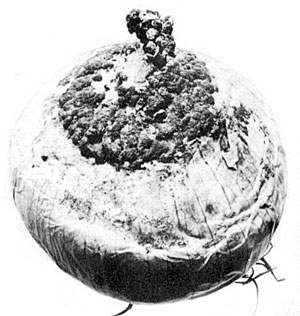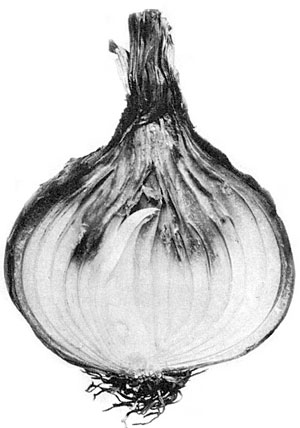Winter is the time to plan gardening and farming practices that will overcome problems from the past year. It is a time of optimism. Looking forward to great success is easy with all the beautiful pictures in seed catalogs, but the rotting vegetables in the root cellar may bring back a handful of bad memories. The damp, cool summer of 2004 is mostly forgotten now, but crops that were not worth harvesting or those that spoiled downstairs are repercussions of that fungus-favoring growing season.
Crops in the onion family were particularly hard hit last summer. If your bad memories include blue, fuzzy garlic or soft, squashy onions, you may want to read on to understand causes and possible solutions for the next growing season.
Organic growers lean on cultural practices to avoid or control these problems. A growing system has to be set up in order for these practices to work, and since you are really trying to eliminate pests or hide your crops from them, your neighbors’ activities may have to be included in your concerns.
Sanitation is key, but organic farmers always have to balance adding crop residue for organic matter versus getting rid of crop residue because it harbors pests. Knowing which disease problem you have and the life cycle of the organism that causes it is the starting point. Don’t destroy valuable organic matter if crop debris is not the major source of disease spores. For example, spores of gray mold blow in almost any summer wind. But if a disease overwinters in a very limited crop, then destroying that debris will go a long way to solving the problem. For example, late blight overwinters here only in potatoes.
Crop rotation is the most rewarding cultural practice on an organic farm. It is used with green manures to add organic matter, manage nutrients, control weeds and to control insects and diseases. But the biology of the pest is a key factor in the effectiveness of rotation, and if you have a single, small garden, then crop rotation is great for most of these benefits but really will not work for insect and disease control.
Factors that must be considered as you consider crop rotation are:
• Host specificity – If a particular disease is limited to a single species or even a single family of crops, then rotation has great potential to help you avoid the problem. An example is early blight in tomatoes. But if the disease affects a wide variety of crops and weeds, then spores are likely to be unavoidable. Examples include white mold of beans, carrots, tomatoes, peppers and many species.
• Persistence – If the pest (such as Colorado potato beetle) can persist only a short time without a host, then you have a great opportunity to get rid of it quickly. But if the problem can hang around year after year in one form or another and wait for you to try again, then crop rotation is unlikely to really help. Black scurf on potatoes is an example.
• Ability to disperse – Some insects (such as the potato leaf hopper) and spores blow in from hundreds of miles away, and the location of your crop makes no difference. Other problems, such as gummy stem blight of cucurbits, may have only limited ability to spread or spread only at limited times and conditions, so crop rotation has real potential.
Management ability is often said to replace chemical inputs for organic growers. To use cultural practices effectively, you have to pay attention to all the factors that you can control. Figure out what the problem is, learn the biology of the organism and decide how to avoid or destroy it in your system.
 |
| This shriveling and softening, beginning at the neck, is Botrytis neck rot on an onion bulb. Photo from Onion Diseases and Their Control, USDA Handbook No. 208. |
 |
| Longitudinal section of an onion bulb affected with Botrytis neck rot. Photo from Onion Diseases and Their Control, USDA Handbook No. 208. |
The Alliums
Now, back to last year’s onion and garlic crops. Problems started early with onion maggots, and by midseason I saw Botrytis leaf blight all over the state. Many of us finished with blue mold on garlic and rotting onions.
Onion maggots are the larvae of a fly (Delia antiqua) that flies around early in the spring and lays eggs at the base of the plant. The maggots crawl down and feed on the roots. On larger onions, maggots may stunt growth, cause yellowed leaves and misshapen onions. When they attack very young seedlings, the plants wilt and simply disappear. If you dont go out to your field for a few days, you may miss seeing the wilt stage and may just wonder what happened to your onion seedlings.
Onion maggots overwinter as pupae in the soil. A big pile of rotting onions from a cleaned out root cellar can attract the flies from all over; they breed and lay eggs in the soil in late summer, then you have a huge population of overwintering pupae – I know from experience. In the spring the pupae develop and flies emerge to hunt for your new onion seedlings.
Sanitation is key. Do not leave a bunch of old cull onions lying around in the summer and fall, and get any that are not worth harvesting out of the field. If you think you may have a big problem, a floating row cover can exclude the early spring population.
Botrytis leaf blight (Botrytis squamosa), under prolonged moist conditions such as those of last summer, can take down whole fields of onions, with most leaves dying. It starts as discrete, circular to oval, grayish to white leaf spots. The disease results in a greatly reduced harvest of small bulbs.
The fungus overwinters as sclerotia (hardened, dormant pieces of fungal mycelia that can resume growth under favorable conditions) on crop debris, on unharvested onions and in onion cull piles. The sclerotia germinate in the spring, then released spores are carried by wind over relatively long distances to onion leaves. Given sufficient moisture for long enough time on leaves, the spores germinate and the disease cycle begins again.
Regular rotation will prevent sclerotia from building up in the soil, where they can persist for two years. Cull onions should be eliminated, and leaf debris should be plowed deeply to bury sclerotia. Rotation will work only if your fields are isolated from your old fields and from those of neighbors with the problem. The best nonchemical solution is nice dry weather and managing overhead irrigation to avoid prolonged leaf wetness.
Rotting onions were common last fall for two reasons: Botrytis neck rot and sour skin. Sour skin is a disease caused by bacteria (Pseudomonas cepacia), and Botrytis neck rot is caused by the fungus Botrytis. These rots are common in onions after harvest and going into storage. Sour skin begins in the field with one or two leaves turning yellow to brown. After harvest or in storage, a few outer bulb scales turn yellow and soft. These diseased scales can be separated easily from the healthy ones. With neck rot the disease is first seen as rotting scales in the neck area, then it advances down toward the base.
Sclerotia from cull onions are the primary source of neck rot infection. It is also seedborne. In wet weather plants are infected by airborne spores from other infected plants. Infection can also occur during harvest if bulbs are damaged. Neck rot control is based on sanitation, e.g., eliminate cull piles, bury debris deeply, and rotate out of the onion family for at least two years. Onions with thick necks should be avoided for storage. Home gardeners can use these onions as soon as possible, or peel, chop and freeze them. Storage onions should be cured until they are thoroughly dry before being put into storage, and the storage area should be just above freezing and dry.
Sour skin is also more common in wet years or with prolonged wetness from overhead irrigation. Avoid damage during harvest, and although heat during curing may at first encourage the disease, it should be used if necessary for proper curing.
Blue mold of garlic (Penicillium sp.) is usually seen at harvest and in storage as a blue to green fungal growth on the surface. The first symptoms are pale yellowish blemishes that become watery soft spots. Again, this pathogen does best under moist conditions. The avenue of infection usually is damage at planting or wounding cloves during harvest. Handle cloves with care and avoid planting infected cloves. Rotation is unlikely to be of any value, because Penicillium is common on debris in soil.
About the author: Eric is MOFGA’s director of technical services. You can contact him at [email protected] with your questions about crop growth.
